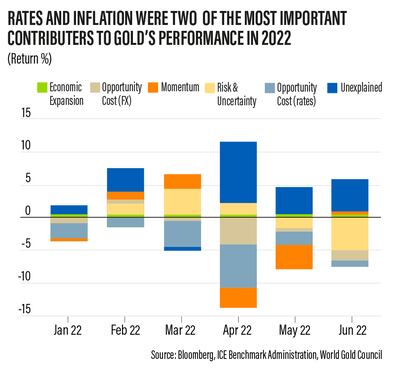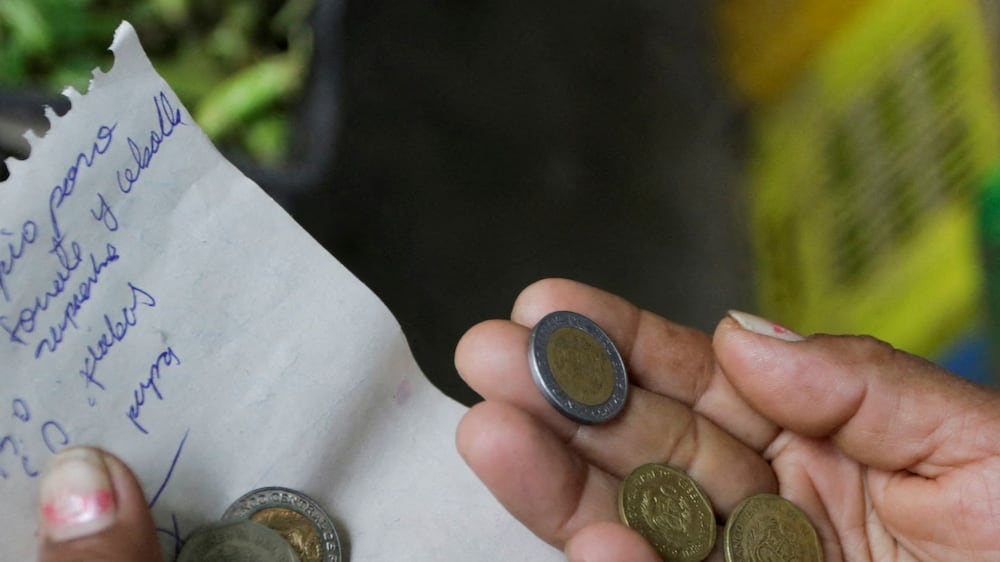Gold prices will remain elevated in the second half of 2022 if stock markets continue to underperform, geopolitical risks persist and inflation remains high, the World Gold Council said in its latest report.
The precious metal, which investors turn to as a hedge against inflation, ended the first half of 2022 up 0.6 per cent, initially rallying as the Russia-Ukraine war unfolded, prompting investors to seek high-quality and liquid hedges amid increased economic uncertainty, the London-based council said in its mid-year review.

Gold's stabilisation was in response to a “tug of war between rising interest rates and a high-risk environment”, the WGC said on Friday.
“The latter was a combination of persistently high inflation, as well as likely support from the extended conflict in Ukraine and its potential knock-on effects on global growth.”
Fears of a global recession have been steadily increasing amid rising inflationary pressure, steep interest rate increases by central banks and Ukraine war.
Investors typically boost their investments in haven assets such as gold during times of heightened geopolitical and economic uncertainty.
Gold gave up some of its early gains in the first half of the year as investors shifted their focus to monetary policy and higher bond yields, with gold exchange-traded funds (ETFs) posting two consecutive months of outflows totalling 81 tonnes worth a combined $4.8 billion in May and June, the WGC said.
However, global holdings of gold ETFs remained strong and were up 6 per cent at 3,792 tonnes worth $221.7bn in the year to date.
Demand for gold ETFs surged in the first quarter of 2022 to 273 tonnes, which was the highest level of quarterly inflows since the third quarter of 2020, the WGC said.
ETFs are baskets of securities consisting of stocks, bonds, commodities or other financial assets that track global markets.
Despite the positive longer-term outlook, gold remains on course for its biggest weekly loss in eight weeks as the US dollar remained close to its 20-year high.
Spot gold inched up 0.1 per cent at $1,744.07 an ounce early on Friday, with US gold futures flat at $1,739.70.
“Gold prices are [in] a freefall mode. Softer US yields and limited risk appetite should normally play in favour of gold, but we see the contrary happening,” Ipek Ozkardeskaya, senior analyst at Swissquote Bank, said in a note.
“The strength of the US dollar clearly overshadows gold and prevents the yellow metal from gaining at a time it could potentially gain … we could see further losses in the yellow metal in the medium run.”
The price of gold is inversely related to the value of the greenback as the metal is dollar-denominated. A stronger dollar makes bullion more expensive for buyers who hold other currencies.
Meanwhile, global gold demand surged 34 per cent in the first quarter of 2022, driven by strong ETF inflows, the WGC report said.
North American and European funds attracted the bulk of investment during the first half of 2022. US fund holdings rose by 133 tonnes ($8.1bn) while European funds added 119 tonnes ($7.5bn), it said.
Funds in “other” regions — which include the UAE, Saudi Arabia, Australia, South Africa and Turkey — rose by a marginal 2 tonnes.
Asia was the only region to post net outflows in the six-month period, dropping 16 tonnes, with Chinese funds the main contributor.
“While the bulk of Chinese outflows occurred during Q1, impacted by the New Year holiday and tactical trading into a rising gold price, lower gold price volatility and profit-taking led to further outflows in Q2,” the WGC said.
Why is everything so expensive right now?

Despite the “picture of strength for the second half of 2022", gold will continue to face the same two key headwinds from the first half of 2022 — higher nominal interest rates and a potentially stronger dollar, the WGC said.
However, the negative effect from these two drivers may be offset by other, more supportive factors, including high and persistent inflation, market volatility linked to shifts in monetary policy and geopolitics, and the need for effective hedges that overcome potentially higher correlations between equities and bonds.
“Investors around the world face a challenging environment during H2 2022, needing to navigate a noxious compound of rising interest rates, high inflation and geopolitical risks,” the WGC said.
“In this context, gold’s strategic and tactical role will likely remain relevant to investors, particularly while uncertainty stays elevated.
However, the negative effect from these two drivers may be offset by other, more supportive factors, including high and persistent inflation, market volatility linked to shifts in monetary policy and geopolitics and the need for effective hedges that overcome potentially higher correlations between equities and bonds.







